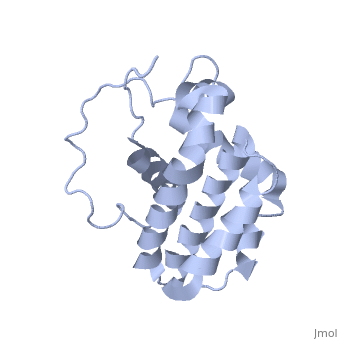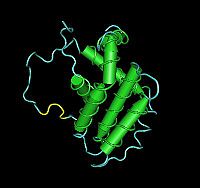B-cell lymphoma protein
From Proteopedia
| Line 1: | Line 1: | ||
{{STRUCTURE_1g5m | PDB=1g5m | SCENE= }} | {{STRUCTURE_1g5m | PDB=1g5m | SCENE= }} | ||
[[Image:Bcl-2_3D.jpg|left|200px]] | [[Image:Bcl-2_3D.jpg|left|200px]] | ||
| - | == | + | ==Overview== |
| - | + | Bcl-2 is a family of genes and proteins that govern the mitochondrial membrane permeabilization (MMP). Bcl-2 derives its name from B-cell lymphoma 2 which came from being the second member of a range of proteins initially described as a reciprocal gene translocation in chromosomes 14 and 18 in follicular lymphomas. The genes and proteins can be either pro-apoptotic (Bax, BAD, Bak and Bok) or anti-apoptotic (Bcl-2, Bcl-xL, and Bcl-w). | |
| - | + | ||
| - | + | ||
| - | + | ||
| - | + | ||
| - | + | ||
| + | Apoptosis is the programmed death of cells. It is central to the development and homeostasis of multicellular organisms, and it is the route by which unwanted or harmful cells are eliminated from the organism. The mitochondria is a large contributor in the subcellular partitioning of the apoptotic activator molecules such as cytochrome c. There are several triggering agents such as Ca2+, reactive oxygen species, certain lipid molecules and certain protein kinases that can induce MMP. The interaction opens the protein permeable pores that allow the release of several proteins including cytochrome c, Smac/Diablo, AIF, Endonuclease G, etc. Depending on their activated function, Bcl-2 either promotes the release or sequesters the function of the specific proteins. | ||
==Role in disease== | ==Role in disease== | ||
[[Image:signal transduction.jpg|left|500px]] | [[Image:signal transduction.jpg|left|500px]] | ||
| - | |||
| - | The Bcl-2 gene has been implicated in a number of cancers, including melanoma, breast, prostate, and lung carcinomas, as well as schizophrenia and autoimmunity. It is also thought to be involved in resistance to conventional cancer treatment. This supports a role for decreased apoptosis in the pathogenesis of cancer. | ||
| - | |||
| - | Cancer is one of the world's leading causes of death and occurs when the homeostatic balance between cell growth and death is disturbed. Research in cancer biology has discovered that a variety of aberrations in gene expression of anti-apoptotic, pro-apoptotic and BH3-only proteins can contribute to the many forms of the disease. An interesting example can be seen in lymphomas. The over-expression of the anti-apoptotic Bcl-2 protein in lymphocytes alone did not act in an oncogenic manner. But simultaneous overexpression of Bcl-2 and the protooncogene myc may produce aggressive B-cell malignancies including lymphoma.[8] In follicular lymphoma, a chromosomal translocation commonly occurs between the fourteenth and the eighteenth chromosomes—t(14;18)—which places the Bcl-2 gene next to the immunoglobulin heavy chain locus. This fusion gene is deregulated, leading to the transcription of excessively high levels of bcl-2.[9] This decreases the propensity of these cells for undergoing apoptosis. | ||
| - | |||
| - | Apoptosis also plays a very active role in regulating the immune system. When it is functional, it can cause immune unresponsiveness to self-antigens via both central and peripheral tolerance. "In the case of defective apoptosis, it may contribute to etiological aspects of autoimmune diseases.[10] The autoimmune disease, type 1 diabetes can be caused by defective apoptosis, which leads to aberrant T cell AICD and defective peripheral tolerance. Due to the fact that dendritic cells (DCs) are of the most important antigen presenting cells of the immune system, their activity must be tightly regulated by such mechanisms as apoptosis. "Researchers have found that mice containing DCs that are Bim -/-, thus unable to induce effective apoptosis, obtain autoimmune diseases more so than those that have normal DCs.[10] Other studies have shown that the lifespan of DCs may be controlled by factors such as a timer dependent on anti-apoptotic Bcl-2.[10] These investigations illuminate the importance of regulating antigen presentation as mis-regulation can lead to autoimmunity. | ||
| - | |||
| - | Apoptosis plays a very important role in regulating a variety of diseases that have enormous social impacts. For example, schizophrenia is a neurodegenerative disease that may result from an abnormal ratio of pro- and anti-apoptotic factors.[11] There is some evidence that this defective apoptosis may result from abnormal expression of Bcl-2 and increased expression of caspase-3.[11] | ||
| - | |||
| - | Further research into the family of Bcl-2 proteins will provide a more complete picture on how these proteins interact with each other to promote and inhibit apoptosis. An understanding of the mechanisms involved will help discover potential treatments such as inhibitors to target over-expressed proteins that may lead to new therapies in cancer, autoimmune conditions, and neurological diseases. | ||
==Targeted Therapies== | ==Targeted Therapies== | ||
| - | |||
| - | An antisense oligonucleotide drug Genasense (G3139) has been developed to target Bcl-2. An antisense DNA or RNA strand is non-coding and complementary to the coding strand (which is the template for producing respectively RNA or protein). An antisense drug is a short sequence of RNA which hybridises with and inactivates mRNA, preventing the protein from being formed. | ||
| - | |||
| - | It was shown that the proliferation of human lymphoma cells (with t(14;18) translocation) could be inhibited by antisense RNA targeted at the start codon region of Bcl-2 mRNA. In vitro studies led to the identification of Genasense, which is complementary to the first 6 codons of Bcl-2 mRNA.[12] | ||
| - | |||
| - | These have shown successful results in Phase I/II trials for lymphoma, and a large Phase III trial is currently underway[13] | ||
| - | |||
| - | Genasense did not receive FDA approval after disappointing results in a melanoma trial. | ||
| - | |||
| - | Abbott has recently described a novel inhibitor of Bcl-2, Bcl-xL and Bcl-w, known as ABT-737.[14] ABT-737 is one among many so-called BH3 mimetic small molecule inhibitors (SMI) targeting Bcl-2 and Bcl-2-related proteins such as Bcl-xL and Bcl-w but not A1 and Mcl-1, which may prove valuable in the therapy of lymphoma and other blood cancers.[15] | ||
Revision as of 00:57, 29 October 2009
Overview
Bcl-2 is a family of genes and proteins that govern the mitochondrial membrane permeabilization (MMP). Bcl-2 derives its name from B-cell lymphoma 2 which came from being the second member of a range of proteins initially described as a reciprocal gene translocation in chromosomes 14 and 18 in follicular lymphomas. The genes and proteins can be either pro-apoptotic (Bax, BAD, Bak and Bok) or anti-apoptotic (Bcl-2, Bcl-xL, and Bcl-w).
Apoptosis is the programmed death of cells. It is central to the development and homeostasis of multicellular organisms, and it is the route by which unwanted or harmful cells are eliminated from the organism. The mitochondria is a large contributor in the subcellular partitioning of the apoptotic activator molecules such as cytochrome c. There are several triggering agents such as Ca2+, reactive oxygen species, certain lipid molecules and certain protein kinases that can induce MMP. The interaction opens the protein permeable pores that allow the release of several proteins including cytochrome c, Smac/Diablo, AIF, Endonuclease G, etc. Depending on their activated function, Bcl-2 either promotes the release or sequesters the function of the specific proteins.
Role in disease
Targeted Therapies
Proteopedia Page Contributors and Editors (what is this?)
Michal Harel, Colin Ridenour, David Canner, Alexander Berchansky, Jaime Prilusky




